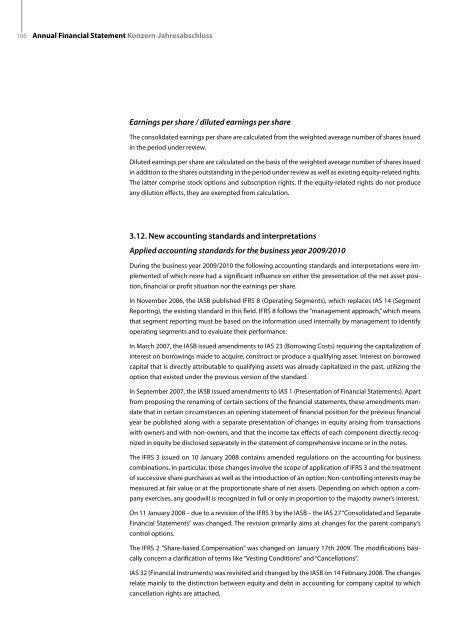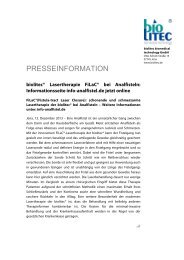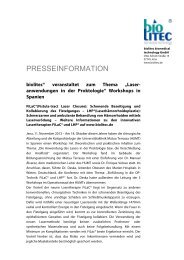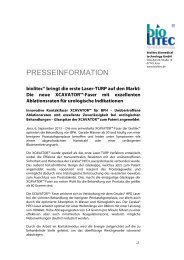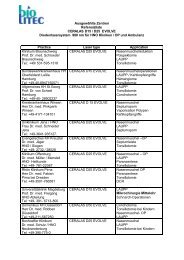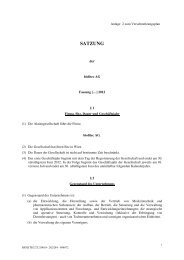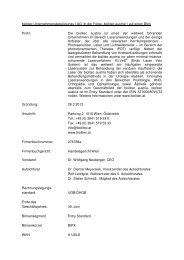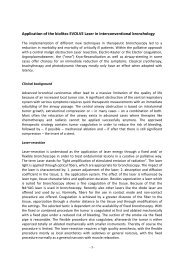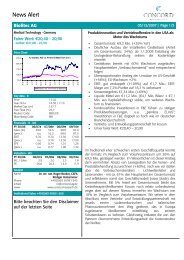Annual Report 2009/2010 Geschäftsbericht 2009/2010 ... - biolitec AG
Annual Report 2009/2010 Geschäftsbericht 2009/2010 ... - biolitec AG
Annual Report 2009/2010 Geschäftsbericht 2009/2010 ... - biolitec AG
Sie wollen auch ein ePaper? Erhöhen Sie die Reichweite Ihrer Titel.
YUMPU macht aus Druck-PDFs automatisch weboptimierte ePaper, die Google liebt.
106 <strong>Annual</strong> Financial Statement Konzern-Jahresabschluss<br />
Earnings per share / diluted earnings per share<br />
The consolidated earnings per share are calculated from the weighted average number of shares issued<br />
in the period under review.<br />
Diluted earnings per share are calculated on the basis of the weighted average number of shares issued<br />
in addition to the shares outstanding in the period under review as well as existing equity-related rights.<br />
The latter comprise stock options and subscription rights. If the equity-related rights do not produce<br />
any dilution effects, they are exempted from calculation.<br />
3.12. New accounting standards and interpretations<br />
Applied accounting standards for the business year <strong>2009</strong>/<strong>2010</strong><br />
During the business year <strong>2009</strong>/<strong>2010</strong> the following accounting standards and interpretations were implemented<br />
of which none had a significant influence on either the presentation of the net asset position,<br />
financial or profit situation nor the earnings per share.<br />
In November 2006, the IASB published IFRS 8 (Operating Segments), which replaces IAS 14 (Segment<br />
<strong>Report</strong>ing), the existing standard in this field. IFRS 8 follows the “management approach,” which means<br />
that segment reporting must be based on the information used internally by management to identify<br />
operating segments and to evaluate their performance.<br />
In March 2007, the IASB issued amendments to IAS 23 (Borrowing Costs) requiring the capitalization of<br />
interest on borrowings made to acquire, construct or produce a qualifying asset. Interest on borrowed<br />
capital that is directly attributable to qualifying assets was already capitalized in the past, utilizing the<br />
option that existed under the previous version of the standard.<br />
In September 2007, the IASB issued amendments to IAS 1 (Presentation of Financial Statements). Apart<br />
from proposing the renaming of certain sections of the financial statements, these amendments mandate<br />
that in certain circumstances an opening statement of financial position for the previous financial<br />
year be published along with a separate presentation of changes in equity arising from transactions<br />
with owners and with non-owners, and that the income tax effects of each component directly recognized<br />
in equity be disclosed separately in the statement of comprehensive income or in the notes.<br />
The IFRS 3 issued on 10 January 2008 contains amended regulations on the accounting for business<br />
combinations. In particular, these changes involve the scope of application of IFRS 3 and the treatment<br />
of successive share purchases as well as the introduction of an option: Non-controlling interests may be<br />
measured at fair value or at the proportionate share of net assets. Depending on which option a company<br />
exercises, any goodwill is recognized in full or only in proportion to the majority owner’s interest.<br />
On 11 January 2008 – due to a revision of the IFRS 3 by the IASB – the IAS 27 “Consolidated and Separate<br />
Financial Statements” was changed. The revision primarily aims at changes for the parent company’s<br />
control options.<br />
The IFRS 2 ”Share-based Compensation” was changed on January 17th <strong>2009</strong>. The modifications basically<br />
concern a clarification of terms like “Vesting Conditions” and “Cancellations”.<br />
IAS 32 (Financial Instruments) was revisited and changed by the IASB on 14 February 2008. The changes<br />
relate mainly to the distinction between equity and debt in accounting for company capital to which<br />
cancellation rights are attached.


